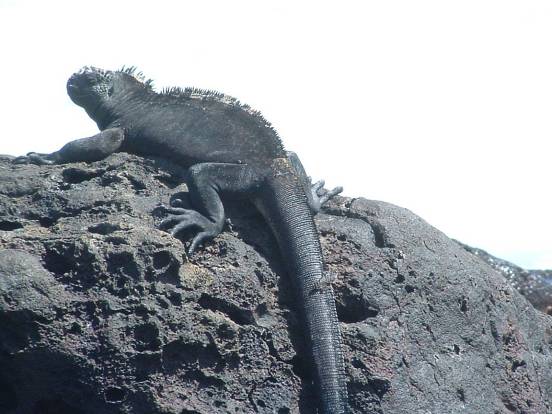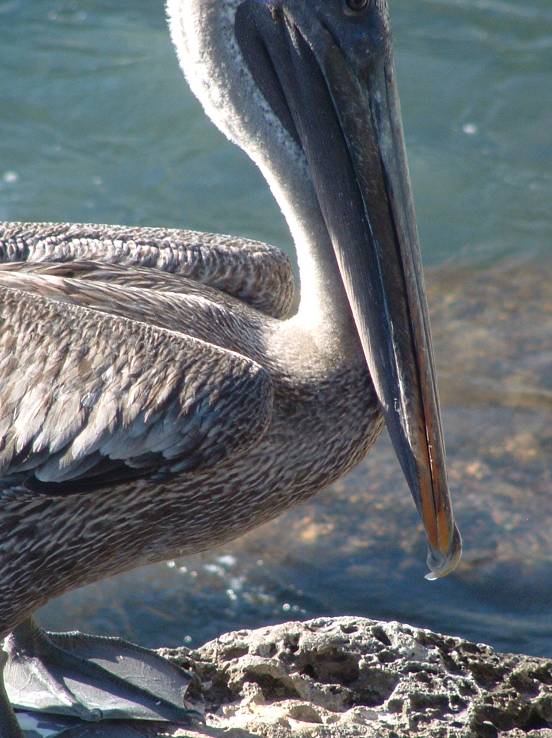PANAMA TO GALAPAGOS - PART 2

|
0:53.74S
89:36.8W Arrival in the
Galapagos Our closing on the Galapagos was prefaced by a red-footed booby (that’s a sea-bird for the ignorant!) sleeping on the guard wires throughout our last night. Finally Isla San Christobal appeared through the haze and on our run into the island we were met by dolphins, a humpback whale and sea-birds unique to the islands such as the red-footed boobies and Galapagos petrels. We finally
anchored in Puerto Baquerizo Moreno ( Our intention
was to just spend the night here before moving on next morning to Puerto Ayora
on Isla Santa Cruz, but we decided that this was a better anchorage, especially
if we were to leave the boat for a few days. Next morning a local agent, Bolivar
came out to the boat and talked through the various options for staying in the
Galapagos, which are very tightly controlled. Yachts arriving without arranging
a permit prior to arrival are allowed to stay for up to 20 days, but must remain
in one of two ports for the entire duration of the stay. It is possible to apply
for an ‘autographo’ beforehand which allows the boat to travel between three
ports in the archipelago. We negotiated with Bolivar who sad it may be possible
to obtain an autographo after about 8 days if he could send the application off
to Meanwhile we have discovered that Puerto Baquierizo Moreno is a charming little town, considerably enlarged and developed over the last few years, particularly as the airport has been improved to handle international flights. After a lazy couple of days relaxing after the voyage and sorting the boat out, we took a 7-hout taxi ride (4-door pick-up actually) around the island to see all the sights and the unique flora and fauna of these islands. San Christobal is the oldest of the Galapagos, formed about 4 million years ago and therefore has more established vegetation than some of the newer volcanic islands. There is an excellent interpretation centre here, explaining the geology, unique flora and fauna and the human history of the island. We visited beautiful deserted beaches to watch the sea lions and blue marine iguanas, drove through the clouds to the highest levels on the island and went to a tortoise sanctuary and breeding centre for the unique San Christobal giant tortoises.
San Christobal
vegetation
Feeding
time
E.T.
Shy – won’t come out of
shell
Galapagos finch – one of 14
different sub-species, but I don’t which one!
The tortoise
hatchery
And another
finch!
Marine
iguana
Puerto Baqierizo Each of the islands, due to their isolation has developed their own varieties of birds, flora and the giant tortoises. Unfortunately the early effect of Man visiting these islands wiped out 5 of the indigenous species of tortoise (Galapago is Spanish for tortoise) and there are now major efforts to conserve the remaining species.
Lucy, Tony and Bernardo,
the taxi driver, striding around the crater lake
Sally Llightfoot
crab
The last few days have been spent cleaning and maintaining the boat (a never-ending process) visiting a few local sights, such as the volcanic crater lake, and enjoyable evenings ashore drinking and dining with various fellow yachties. Tony leaves us
in the next couple of days and we shall then, hopefully stay a couple more weeks
visiting other islands before heading the 3000 miles across the Pacific to the
Marquesas in Oh yes – the enemy? We are fighting a defensive action to stop sea lions boarding the boat. They are wonderful, fascinating creatures that one could watch all day, but the do like to get aboard boats for a nice comfortable sleep. Unfortunately once there they are messy, smelly and unwilling to leave. That is not too much of a problem with the small pups, but a 250lb. bull sea lion is a distinctly different and more difficult matter!
Our
defences
The
enemy
Dangerous-looking aren’t
they!
Hi
there
Pretending to be a
shark
We give
up |




























